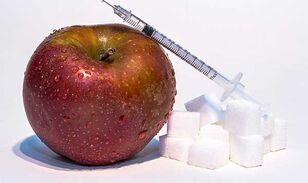
The ketogenic, or ketone, or keto diet is one of the well-studied food systems that has been shown to be useful in many experiments and clinical trials.
However, the scheme is complex. It is not suitable for everyone and has many pitfalls.
What is the keto diet
This is a low carb food and a high fat menu. Like the regular carb-free diet or the Atkins diet.
A diet in which the amount of carbohydrates is significantly reduced and fat intake is increased, turns the body into ketosis.
Ketosis is a metabolic condition in which fat is the body's main source of energy. This happens when the intake of carbohydrates, usually the main source of energy, is minimized.
Ketosis occurs during fasting, pregnancy and lactation. It can be induced artificially in adults by switching to a high-fat, low-carbohydrate diet.
In ketosis, insulin levels fall. Fatty acids in large quantities leave adipose tissue and enter the liver, where they are oxidized and converted into ketone bodies or ketones, which are a source of energy.
Created:
- beta-hydroxybutyrate, the main ketone body circulating in the blood;
- acetoacetate - the main product of the liver;
- acetone is a volatile ketone responsible for the formation of a specific odor from the breath.
Ketone bodies are able to penetrate the blood-brain barrier and feed brain cells in the absence of glucose.
The constant decline in insulin and sugar levels seen in a ketogenic diet has many beneficial effects on human health.
How is ketosis different from ketoacidosis
Ketosis, which develops with a carbohydrate-free diet, is radically different from diabetic ketoacidosis.
People without diabetes have normal blood sugar levels. When carbohydrate stores are depleted, the liver begins to produce glucose from other sources (pyruvate, glycerol and amino acids).
This makes it possible to maintain normal blood glucose levels and ensure a ketone body concentration within 8 Mmole / L, which is safe for health.
In type 1 diabetics, the level of ketones reaches 20 Mmol / L. And this condition is already life-threatening.

What keto meals are: options
- Standard protocol. This means eating a lot of protein and fat and minimizing carbohydrates - no more than 50 g per day. The menu includes 75% fat, 20% protein and 5% carbohydrates.
- Keto diet high in protein. Same as the standard regimen, only more protein. 60% fat, 35% protein, 5% carbohydrates.
- Cyclic option. In this diet, 5 days are followed by a standard diet, and 2 days are high in carbohydrates. Reminds me of the BUCH diet.
- Target approach. They eat according to the ketogenic scheme and consume carbohydrates before and after training.
All research evaluates only the standard version.
The cyclical and focused approach is used only by athletes, mostly bodybuilders. These eating patterns are not designed to help you lose weight or improve your health.
How the keto diet affects weight loss
Scientific evidence suggests that this is a highly effective weight loss method that provides more consistent results than traditional low-fat weight loss systems, which require strict calorie restriction.
It has been shown that those who lose weight on a ketogenic diet lose 2. 2 times more pounds of excess weight, those volunteers who have been on a low-fat diet with strict calorie restriction.
The mechanisms of weight loss in the keto diet are as follows.
- Significant intake of protein, which is necessary for stable healthy weight loss.
- Gluconeogenesis. Proteins and fats are converted into carbohydrates. This process can burn extra calories throughout the day.
- Suppress appetite. Ketogenic diet normalizes the levels of the hormones leptin and ghrelin, which are responsible for eating behavior.
- Increase insulin sensitivity. Insulin resistance leads to weight gain. Therefore, increasing the sensitivity to the hormone speeds up the metabolism and promotes the rapid breakdown of fat deposits and reduces the rate of formation of new ones.
Treatment and prevention of metabolic syndrome and type 2 diabetes

Metabolic syndrome is a metabolic disorder that significantly increases the risk of obesity, type 2 diabetes and heart disease.
Signs that a person has a metabolic syndrome are:
- hanging blood pressure;
- abdominal obesity (large abdomen);
- high blood sugar (even if diabetes has not yet been diagnosed);
- bad lipid profile (rules for self-decoding cholesterol analysis).
All of these indicators can be improved without medication by changing lifestyle and diet, for example by switching to a ketone diet.
- Increasing the sensitivity of the body's cells to the hormone insulin plays an important role in the treatment and prevention of diabetes and metabolic syndrome. With the keto diet, insulin sensitivity increases by 75%. Some people with diabetes may even stop taking their medication.
- Improved lipid profile. Positive changes affect both cholesterol and triglyceride levels.
- Additional support for the body is provided by the formation of ketone bodies, which in themselves have beneficial properties.
What other therapeutic effects does the keto diet have?
- Help in the treatment of epilepsy. A current meta-analysis of 70 clinical trials found that the keto diet reduced the number of seizures by 50% in 46-62% of cases. The exact mechanism of dietary anticonvulsant action has not been established. Scientists believe that the positive effect may be associated with an increase in the amount of the antioxidant glutathione in the mitochondria, an increase in the effect of the inhibitory neurotransmitters GABA and adenosine, and others.
- Therapy of Alzheimer's disease. Several small studies have shown that ketone diet improves the condition of patients with mild Alzheimer's disease. In patients with this disease, the supply of glucose to the brain is disrupted. And keto bodies make it possible to feed the brain with energy without the involvement of glucose, while reducing the toxic effects of glutamate.
- Support for patients with parkinsonism. According to several studies, a carbohydrate-free diet is beneficial for people with Parkinson's disease because it prevents the death of dopaminergic neurons and mitochondrial damage.
- Help for children with autism. It has been suggested that the keto diet improves behavior in children with autism. And it makes it more effective than the Atkins diet, a gluten- and casein-free food. However, the data on this issue are still so small that they cannot be considered completely reliable.
- Cancer treatment. Tumor cells work exclusively on glucose. They cannot get energy from ketone bodies. Therefore, the transition to ketogenic nutrition promotes cell death in malignant neoplasms. However, experts emphasize that the method can be used only in conjunction with chemotherapy and with a doctor's permission. And don't expect too much from this approach.
- Improves skin condition. In particular, eliminate acne. Low insulin levels and the elimination of all industrially produced foods from the diet, as required by the diet, eliminate chronic inflammation affecting the skin.
- Treatment of polycystic ovary syndrome. The disease is associated with impaired glucose and androgen metabolism. The ketogenic diet helps to restore the insulin sensitivity that plagues women with polycystic ovary syndrome.
Advantages and disadvantages of the keto diet: food list

- Sugar in any form. Obviously, sweet foods (pastries, ice cream) and those that do not look sweet but contain this ingredient in their composition are also classified as prohibited. You can even buy ketchup in the store.
- Cereals: wheat (including spelled), rye, barley, rice, corn.
- Vegetable oils that fill you - soy, corn, sunflower, canola. And also trans fats.
- Fruits. Except for a small amount of fruit, such as strawberries.
- Legumes. Beans, peas, lentils, etc. Can be used in green, such as beans.
- Tubers and rhizomes. Potatoes, carrots, beets, parsnips, etc.
- Any "dietary" food, such as low-fat cottage cheese (in such products, fat is replaced by sugar).
- Products with sweeteners in the form of sugar alcohols (xylitol, erythritol) - have a negative effect on ketone bodies.
- Dips and sauces, in the preparation of which sugar, starch, flour are used.
- Alcohol.
- All finished products from the food industry.
The ketogenic diet: what you can and should eat
- All types of meat: beef, pork, poultry, lamb, etc.
- Fish and seafood.
- Eggs.
- Vegetables. Preferably green. Others are allowed (tomatoes, eggplants, onions, peppers) - the most important thing is that there is a lot of fiber and virtually no digestible carbohydrates.
- Fatty dairy products - cream, butter, cheese.
- Nuts and seeds.
- Mushrooms.
- The right vegetable oils: olive oil, coconut oil, avocado.
- Fermented foods: natural yogurt, kefir, sauerkraut and more.
- Spices and herbs.
Sample weekly menu for women and men on a ketogenic diet
| Monday | Tuesday |
Breakfast: scrambled eggs with bacon and tomatoes. Lunch: cauliflower and broccoli soup in chicken broth, boiled chicken with eggplant and a hundred pepper sauce. Dinner: a piece of red fish baked in sour cream with vegetable salad. |
Breakfast: natural fatty yogurt without sweeteners or aromas with nuts and / or seeds. Lunch: bone broth (preferably beef) with hard-boiled egg, a piece of boiled beef with sauerkraut (without potatoes). Dinner: chicken stew with zucchini. |
| Wednesday | Thursday |
Breakfast: scrambled eggs with pepper. Lunch: fish soup (without potatoes), pork chop with green bean stew. Dinner: baked chicken breasts with sour cream, cucumbers and tomatoes. |
Breakfast: cottage cheese with normal fat without sugar and flavors. Lunch: mushroom soup (without potatoes and noodles), minced meat steak with egg and vegetable salad. Dinner: fish baked under the rind of cheese with vegetables. |
| Friday | Saturday |
Breakfast: soft-boiled eggs with a piece of cheese. Lunch: sauerkraut soup (without potatoes), chicken livers, stewed with sour cream and fried onions, with shirataki noodles. Dinner: salad with fish and / or seafood (without potatoes and rice), but with green vegetables, tomatoes, etc. |
Breakfast: cottage cheese with herbs. Lunch: bone broth with meatballs (without flour or bread), beef azu with stewed cabbage (fresh or sour). Dinner: boiled chicken with radish and cucumber salad. |
| Sunday | Move to next week |
Breakfast: scrambled eggs with feta cheese. Lunch: Light vegetable soup with cauliflower and broccoli (without potatoes), whole baked chicken, with cucumber and tomato salad. Dinner: mushrooms stewed with sour cream, with vegetable salad. |
Repeat the first week, trying to add maximum variety to the menu. There are a huge number of recipes to satisfy the keto diet. |
Rules to follow
- You can and should eat satiety without counting calories.
- Only the right fats can be eaten. This means that cooking is only allowed with oil, which can withstand heat treatment. Salads should be lubricated only with the right food dressings.
- There should be a lot of fat in the diet. You can't focus on protein.
- Tea, coffee, instant chicory and many other drinks are allowed. The main selection criterion is the lack of sugar and sweeteners in the drink.
- You should try to put a lot of spices in your diet.
Healthy snacks for weight loss on a ketogenic diet
Because the ketogenic diet does not require calorie counting, breakfast is not only allowed, but even encouraged. But they must be right.
Allowed:
- boiled eggs;
- meat chips;
- siren;
- nuts, seeds and various pastes and oils prepared therefrom;
- fruits, such as strawberries with cream (however, you should not indulge in fruit);
- natural yoghurt and other natural fermented milk products;
- all vegetables allowed by the diet, and light salads from them.
All dairy products, whether cheese or yoghurt, must be of normal fat content.
What is keto flu: symptoms
The first few days of switching to a low-carb diet can be difficult. Unpleasant symptoms often called "keto flu" are common.
Can be highlighted:
- Constant hunger, especially sugar hunger;
- fatigue;
- insomnia;
- abdominal discomfort, stomach pain;
- nausea and vomiting; constipation or diarrhea;
- concentration problems;
- headache and dizziness;
- muscle aches and cramps;
- irritability, crying.
How long does ketoflu last
From a few days to a few weeks. It is associated with the restructuring of the body with the use of fat as the main source of fuel. While adapting, the energy may not be enough, which leads to the listed symptoms, which are unpleasant. But they do not pose any danger.
Ketone bodies are always present in the blood in small amounts. After the first 2-3 days of a strict carbohydrate-free diet, the liver begins to produce ketones and their blood levels rise to 2-3 mM.
Adaptation is complete when cells placed under carbohydrate fasting conditions reduce the absorption of ketone bodies from the blood, increasing their concentration to 8 mM. At this point, efficient transport of ketones across the blood-brain barrier begins.
Why some people easily adapt to a ketogenic diet, while others are difficult, is not clear. Human eating habits are thought to matter. The more easily digestible carbohydrates it consumes, the more difficult the transition. Genetic predisposition is of some importance.
How to quickly get into ketosis on a keto diet

- Correct water mode. When carbohydrates are eliminated from the diet, glycogen stores are reduced in the body. As glycogen accumulates water around itself, dehydration can develop as it decreases, leading to fatigue and muscle aches.
- Only light physical activity. During the period of adaptation of the body, only light exercises are allowed: walking, yoga, slow cycling. All types of grueling fitness should be abandoned.
- Recommended intake of mineral supplements:
- sodium - 3-4 grams per day;
- potassium - 1g;
- magnesium - 0, 3g.
Creatine monohydrate and caffeine supplements are also added.
Keto respiration and specific urine odor
The transition to a low-fat, low-fat diet is often accompanied by the appearance of a specific bad breath. The person himself often feels it as a metallic taste in the mouth. People around you usually perceive it as the smell of nail polish remover. Some people think it smells like fruit. The same odor is acquired from urine.
The phenomenon is caused by the formation of volatile acetone ketone, which is often found in varnish removers.
The smell is not a side effect. This simply shows that the body is switching to fat and forming ketone bodies. It is harmless to health. But it can be unpleasant for the person and others, especially when it comes to breathing.
To reduce the severity of the symptom, you should:
- drink more fluids;
- eat less protein;
- use mint gum;
- slightly increase the amount of carbohydrates (only if you eat less than 50 g per day).
After 1-2 weeks the odor should disappear on its own.
Delayed side effects from the keto diet
In addition to ketoflu, which goes away within a few weeks, this diet can lead to delayed side effects. Possible:
- problems with the digestive system caused by excessive fat intake and dysfunction of the intestinal microflora;
- gradual rise in cholesterol levels;
- increased burden on the kidneys, which may increase the likelihood of developing kidney failure and cause urolithiasis;
- decreased bone density.
Potential nutritional deficiencies in long-term ketogenic diet

As the diet cannot be called balanced, the long stay of this diet can lead to a lack of some important components.
- Calcium. Leaves in the urine. Because with excess fat, the urine becomes too acidic and the body is forced to alkalize it with calcium. In addition, the lack of carbohydrates impairs the absorption of this trace element.
- Magnesium. According to the assumptions, the gradual development of the deficit is associated with the withdrawal from the diet of foods rich in this trace element - cereals and fruits.
- Iron. The abundance of fat in the diet disrupts the absorption of iron.
- Sodium and potassium. Due to the decrease in insulin levels, the loss through the kidneys increases. However, unlike other trace elements, such as calcium or magnesium, the lack of which is established over time, potassium and sodium disappear quickly. And in many ways, their deficiency is due to the symptoms of keto flu, which gradually pass.
- Selenium. The deficiency may be due to the lack of this trace element in foods rich in fat. An exception is the Brazil nut, a piece of which gives the body 100% of the daily value of selenium.
- Carnitine. The disadvantage is that the compound is consumed too quickly on a fatty diet.
If you have been on a keto diet for a long time, you should regularly check the level of all these substances, which may become deficient over time. It is recommended that you take nutritional supplements at risk.
Who should not switch to keto food: contraindications
- Children, pregnant and lactating women, patients with diabetes and cancer have the right to switch to a ketogenic diet only if prescribed by their doctor and under his supervision.
- The diet is contraindicated in people with ApoE3 and ApoE4 genotypes, as it can lead to life-threatening increases in cholesterol levels.
- Do not follow patients with epilepsy with the KCNJ11 and BAD genes.
- Serious liver and / or kidney disease are contraindications to following this diet.
Conclusion
The keto diet is a rather difficult food system that requires almost complete rejection of carbohydrates and the introduction of a significant amount of fat in the diet.
Switching to a ketogenic diet is often difficult to tolerate.
The diet has received a great deal of scientific research, many of which prove its benefits for weight loss, treatment of type 2 diabetes and neurodegenerative diseases, normalization of lipid profiles and elimination of the metabolic syndrome.
However, there are not many studies to evaluate the health effects of a long-term (more than a year) diet. And according to some assumptions, the constant presence of such a diet can mean harm to health.
































